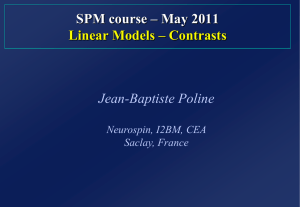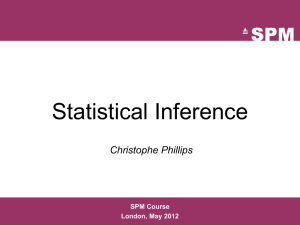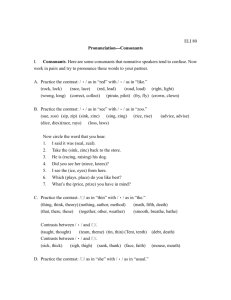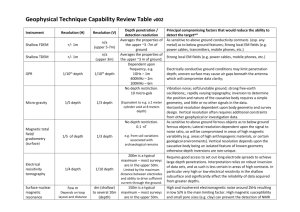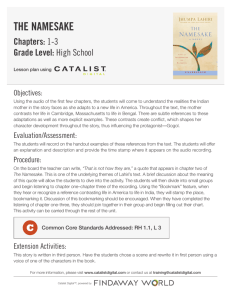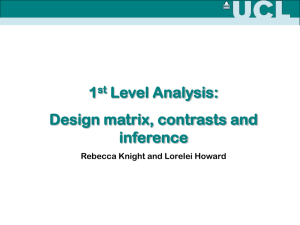1stlevel_2012_final
advertisement
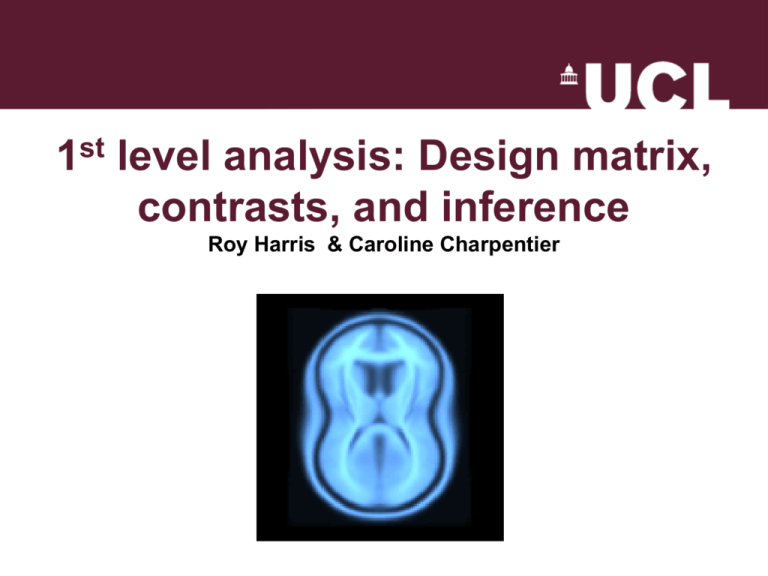
1st level analysis: Design matrix, contrasts, and inference Roy Harris & Caroline Charpentier Outline What is ‘1st level analysis’? The Design matrix What are we testing for? What do all the black lines mean? What do we need to include? Contrasts What are they for? t and F contrasts How do we do that in SPM8? Levels of inference A [1 B C D -1 -1 1] Overview fMRI time-series Motion correction kernel Design matrix Smoothing General Linear Model Statistical Parametric Map Parameter Estimates Spatial normalisation Standard template Once the image has been reconstructed, realigned, spatially normalised and smoothed…. The Rebecca next stepKnight is to statistically analyse the data Key concepts 1st level analysis – A within subjects analysis where activation is averaged across scans for an individual subject The Between - subject analysis is referred to as a 2nd level analysis and will be described later on in this course Design Matrix –The set of regressors that attempts to explain the experimental data using the GLM A dark-light colour map is used to show the value of each variable at specific time points – 2D, m = regressors, n = time. The Design Matrix forms part of the General linear model, the majority of statistics at the analysis stage use the GLM General Linear Model Generic Model Y = X x β + ε Dependent Variable Independent Variable Relative Contribution Error (The difference of X to the overall between the observed (What you are (What you are data (These need to data and that which is measuring) manipulating) be estimated) predicted by the model) Aim: To explain as much of the variance in Y by using X, and thus reducing ε Y = X1β1 + X2β2 + ....X n βn.... + ε GLM continued How does this equation translate to the 1st level analysis ? Each letter is replaced by a set of matrices (2D representations) Y = X x β Matrix of BOLD Design matrix Parameters matrix at various time points (This is your model (These need to be in a single voxel specification in SPM) estimated) (What you collect) Time (rows) Parameter weights (rows) Time (rows) 1 x column (Voxel) Regressors (columns) ε + Error matrix (residual error for each voxel) Time (rows) 1 x Column ‘Y’ in the GLM Y = Matrix of Bold signals fMRI brain scans Voxel time course Y Time Time (scan every 3 seconds) Rebecca Knight Amplitude/Intensity 1 voxel = ~ 3mm³ ‘X’ in the GLM X = Design Matrix Time (n) Regressors (m) Regressors Regressors – represent the hypothesised contribution of your experiment to the fMRI time series. They are represented by the columns in the design matrix (1column = 1 regressor) Regressors of interest i.e. Experimental Regressors – represent those variables which you intentionally manipulated. The type of variable used affects how it will be represented in the design matrix Regressors of no interest or nuisance regressors – represent those variables which you did not manipulate but you suspect may have an effect. By including nuisance regressors in your design matrix you decrease the amount of error. E.g. - The 6 movement regressors (rotations x3 & translations x3 ) or physiological factors e.g. heart rate, breathing or others (e.g., scanner known linear drift) Conditions Termed indicator variables as they indicate conditions Type of dummy code is used to identify the levels of each variable Changes in the bold activation associated with the presentation of a stimulus E.g. Two levels of one variable is on/off, represented as ON = 1 When you IV is presented OFF = 0 When you IV is absent (implicit baseline) Red box plot of [0 1] doesn’t model the rise and falls Fitted Box-Car Modelling haemodynamics Ways to improve your model: modelling haemodynamics • The brain does not just switch on and off. • Convolve regressors to resemble HRF Original HRF Convolved HRF basic function Designs Block design Intentionally design events of interest into blocks Event- related design Retrospectively look at when the events of interest occurred. Need to code the onset time for each regressor Regressors A dark-light colour map is used to show the value of each regressor within a specific time point Black = 0 and illustrates when the regressor is at its smallest value White = 1 and illustrates when the regressor is at its largest value Grey represents intermediate values The representation of each regressor column depends upon the type of variable specified ) Regressors of no interest Variable that can’t be described using conditions E.g. Movement regressors – not simply just one state or another The value can take any place along the X,Y,Z continuum for both rotations and translations Covariates E.g. Habituation Including them explains more of the variance and can improve statistics Summary The Design Matrix forms part of the General Linear Model The experimental design and the variables used will affect the construction of the design matrix The aim of the Design Matrix is to explain as much of the variance in the experimental data as possible Contrasts and Inference • • • • • Contrasts: what and why? T-contrasts F-contrasts Example on SPM Levels of inference Contrasts and Inference • • • • • Contrasts: what and why? T-contrasts F-contrasts Example on SPM Levels of inference Contrasts: definition and use • After model specification and estimation, we now need to perform statistical tests of our effects of interest. • To do that contrasts, because: – Usually the whole β vector per se is not interesting – Research hypotheses are most often based on comparisons between conditions, or between a condition and a baseline • Contrast vector, named c, allows: – Selection of a specific effect of interest – Statistical test of this effect Contrasts: definition and use • Form of a contrast vector: cT = [ 1 0 0 0 ... ] • Meaning: linear combination of the regression coefficients β cTβ = 1 * β1 + 0 * β2 + 0 * β3 + 0 * β4 ... • Contrasts and their interpretation depend on model specification and experimental design important to think about model and comparisons beforehand Contrasts and Inference • • • • • Contrasts: what and why? T-contrasts F-contrasts Example on SPM Levels of inference T-contrasts • One-dimensional and directional – eg cT = [ 1 0 0 0 ... ] tests β1 > 0, against the null hypothesis H0: β1=0 – Equivalent to a one-tailed / unilateral t-test • Function: – Assess the effect of one parameter (cT = [1 0 0 0]) OR – Compare specific combinations of parameters (cT = [-1 1 0 0]) T-contrasts • Test statistic: T cT ˆ var( cT ˆ ) contrast of estimated parameters cT ˆ ˆ 2cT X T X c 1 ~ tN p T= variance estimate • Signal-to-noise measure: ratio of estimate to standard deviation of estimate T-contrasts: example • Effect of emotional relative to neutral faces • Contrasts between conditions generally use weights that sum up to zero • This reflects the null hypothesis: no differences between conditions • No effect of scaling [ ½ ½ -1 ] [ 1 1 -2 ] Contrasts and Inference • • • • • Contrasts: what and why? T-contrasts F-contrasts Example on SPM Levels of inference F-contrasts • Multi-dimensional and non-directional [ 1 0 0 0 ... ] – eg c = [ 0 1 0 0 ... ] (matrix of several T-contrasts) [ 0 0 1 0 ... ] – Tests whether at least one β is different from 0, against the null hypothesis H0: β1=β2=β3=0 – Equivalent to an ANOVA • Function: – Test multiple linear hypotheses, main effects, and interaction – But does NOT tell you which parameter is driving the effect nor the direction of the difference (F-contrast of β1-β2 is the same thing as F-contrast of β2-β1) F-contrasts • Based on the model comparison approach: Full model explains significantly more variance in the data than the reduced model X0 (H0: True model is X0). • F-statistic: extra-sum-of-squares principle: X0 X1 X0 F = SSE 2 ˆ full SSE0 2 ˆ reduced F = SSE0 - SSE SSE Explained variability Error variance estimate or unexplained variability Full model ? or Reduced model? Contrasts and Inference • • • • • Contrasts: what and why? T-contrasts F-contrasts Example on SPM Levels of inference 1st level model specification Henson, R.N.A., Shallice, T., Gorno-Tempini, M.-L. and Dolan, R.J. (2002) Face repetition effects in implicit and explicit memory tests as measured by fMRI. Cerebral Cortex, 12, 178-186. An Example on SPM Specification of each condition to be modelled: N1, N2, F1, and F2 - Name - Onsets - Duration Add movement regressors in the model Filter out lowfrequency noise Define 2*2 factorial design (for automatic contrasts definition) The Design Matrix Regressors of interest: - β1 = N1 (non-famous faces, 1st presentation) - β2 = N2 (non-famous faces, 2nd presentation) - β3 = F1 (famous faces, 1st presentation) - β4 = F2 (famous faces, 2nd presentation) Regressors of no interest: - Movement parameters (3 translations + 3 rotations) Contrasts on SPM F-Test for main effect of fame: difference between famous and non –famous faces? T-Test specifically for Non-famous > Famous faces (unidirectional) Contrasts on SPM Possible to define additional contrasts manually: Contrasts and Inference • • • • • Contrasts: what and why? T-contrasts F-contrasts Example on SPM Levels of inference Inferences can be drawn at 3 levels: - Voxel-level inference = height, peak-voxel - Cluster-level inference = extent of the activation - Set-level inference = number of suprathreshold clusters Summary • We use contrasts to compare conditions • Important to think your design ahead because it will influence model specification and contrasts interpretation T-Contrasts F-Contrasts One-dimensional (c = vector) Multi-dimensional (c = matrix) Directional (A > B) Non-directional (A ≠ B) • T-contrasts are particular cases of F-contrasts – One-dimensional F-Contrast F=T2 • F-Contrasts are more flexible (larger space of hypotheses), but are also less sensitive than T-Contrasts Thank you! Resources: • Slides from Methods for Dummies 2009, 2010, 2011 • Human Brain Function; J Ashburner, K Friston, W Penny. • Rik Henson Short SPM Course slides • SPM 2012 Course slides on Inference • SPM Manual and Data Set Special thanks to Guillaume Flandin

